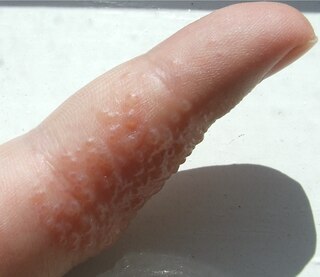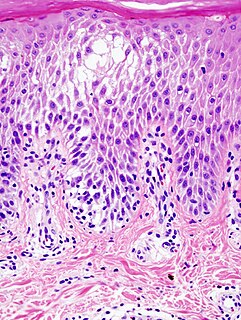
Dermatitis, also known as eczema, is a group of diseases that result in inflammation of the skin. These diseases are characterized by itchiness, red skin and a rash. In cases of short duration, there may be small blisters, while in long-term cases the skin may become thickened. The area of skin involved can vary from small to the entire body.

Dyshidrosis, is a type of dermatitis, that is characterized by itchy blisters on the palms of the hands and bottoms of the feet. Blisters are generally one to two millimeters in size and heal over three weeks. However, they often recur. Redness is not usually present. Repeated attacks may result in fissures and skin thickening.

Erythroderma is an inflammatory skin disease with redness and scaling that affects nearly the entire cutaneous surface. This term applies when 90% or more of the skin is affected.

Keratoderma blennorrhagicum etymologically meaning keratinized (kerato-) skin (derma-) mucousy (blenno-) discharge (-rrhagia) are skin lesions commonly found on the palms and soles but which may spread to the scrotum, scalp and trunk. The lesions may resemble psoriasis.
ICD-10 is an international statistical classification used in health care and related industries.

Acrodermatitis enteropathica is an autosomal recessive metabolic disorder affecting the uptake of zinc through the inner lining of the bowel, the mucous membrane. It is characterized by inflammation of the skin (dermatitis) around bodily openings (periorificial) and the tips of fingers and toes (acral), hair loss (alopecia), and diarrhea. It can also be related to deficiency of zinc due to other, i.e. congenital causes.
Acrodermatitis /ac·ro·der·ma·ti·tis/ is a childhood form of dermatitis selectively affecting the hands and feet and may be accompanied by mild symptoms of fever and malaise. It may also be associated with hepatitis B and other viral infections. The lesions appear as small coppery-red, flat-topped firm papules that appear in crops and sometimes in long linear strings, often symmetric. It is a diffuse chronic skin disease usually confined to the limbs, seen mainly in women in Northern, Central, and Eastern Europe, and characterized initially by an erythematous, oedematous, pruritic phase followed by sclerosis and atrophy. It is caused by infection with Borrelia burgdorferi.

Spongiosis is mainly intercellular edema in the epidermis, and is characteristic of eczematous dermatitis, manifested clinically by intraepidermal vesicles, "juicy" papules, and/or lichenification. It is a severe case of eczema that affects the epidermis, dermis and/or subcutaneous skin tissues. The three types of spongiotic are acute, subacute and chronic. A dermatologist can diagnose acute spongiotic by examining the skin during an office visit but a biopsy is needed for an accurate diagnosis of the type.

The term pustular psoriasis is used for a heterogeneous group of diseases that share pustular skin characteristics.

Periorbital dermatitis is a skin condition, a variant of perioral dermatitis, occurring on the lower eyelids and skin adjacent to the upper and lower eyelids.
Impetigo herpetiformis is a form of severe pustular psoriasis occurring in pregnancy which may occur during any trimester.
Erythema gyratum repens is a figurate erythema that is rapidly moving and usually a marker of underlying cancer, usually from the lung.
Erosive pustular dermatitis of the scalp presents with pustules, erosions, and crusts on the scalp of primarily older Caucasian females, and on biopsy, has a lymphoplasmacytic infiltrate with or without foreign body giant cells and pilosebaceous atrophy.
Localized pustular psoriasis presents as two distinct conditions that must be considered separate from generalized psoriasis, and without systemic symptoms, these two distinct varieties being pustulosis palmaris et plantaris and acrodermatitis continua.

Pustulosis palmaris et plantaris is a chronic recurrent pustular dermatosis localized on the palms and soles only, characterized histologically by intraepidermal pustules filled with neutrophils. It can occur as part of the SAPHO syndrome.

Transient neonatal pustular melanosis is a cutaneous condition that presents at birth with 1- to 3-mm flaccid, superficial fragile pustules, some of which may have already resolved in utero, leaving pigmented macules.
IgA pemphigus is a subtype of pemphigus with two distinct forms:
Gonococcemia is a condition characterized by a hemorrhagic vesiculopustular eruption, bouts of fever, and arthralgia or actual arthritis of one or several joints.
Farmyard pox is a group of closely related parapoxviruses of sheep and cattle that cause similar diseases in humans. Conditions included in this group are:










